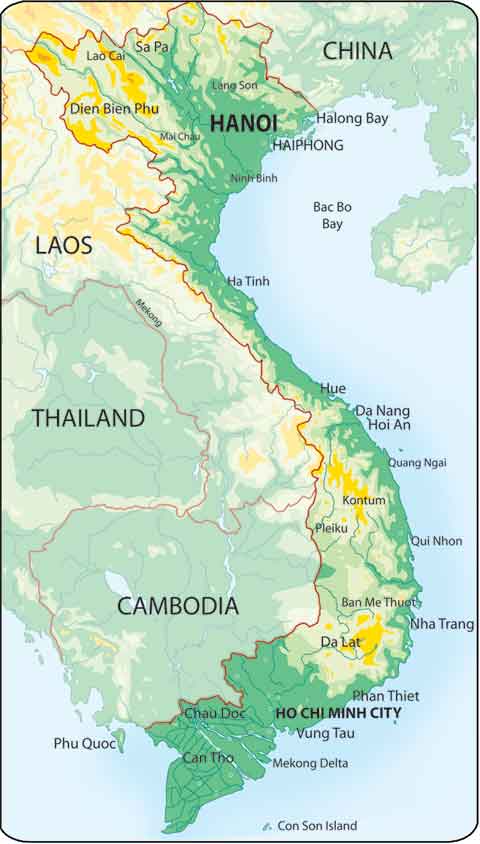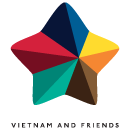
Official name of the country: Socialist Republic of Vietnam
Independence Day: 2nd September 1945
Capital City: Ha Noi
Population: 90.7 Million of inhabitants (2014)
Gross Domestic Product (GDP): $180 Billion
Religion: 80,8 % of atheists, 9,3% of Buddhists, 6,7% of Catholics, 1,5 % of Hoa Hao, 1,1 % of caodaists, 0,5 % of protestants, 0,1% of muslims. The Confucianism also plays an important role in Vietnam associated with other cults.
1. Geography
Vietnam occupies approximately 127,243 square miles (329,560 square kilometers), an area roughly equivalent to New Mexico, and is situated between 8 and 24 degrees latitude and 102 and 110 degrees longitude. It borders China in the north, Laos in the northeast and center, and Cambodia in the southwest. Its 2,135 miles (3,444 kilometers) of coastline run from its border with Cambodia on the Gulf of Thailand along the South China Sea to its border with China. The delineation of Vietnam's borders has been a focus of dispute in the post–1975 period, notably the ownership disputes with China, Malaysia, the Philippines, Taiwan, and Malaysia over the Spratly Islands; and with China and Taiwan over the Paracel Islands. Recent progress has been made settling land border disputes with China and Cambodia. The Vietnamese culturally divide their country into three main regions, the north ( Bac Bo ), center ( Trung Bo ), and south ( Nam Bo ), with Hanoi, Hue, and Ho Chi Minh City (formerly Saigon) serving as the main cities of each region. Hanoi, the site of the former capital of one of the country's earliest dynasties, has been the capital of the unified Vietnam since 1976.
2. History
111 BC: China conquered the northern part of present-day Vietnam. Over the next several centuries Vietnamese culture was strongly influenced by that of China.
AD 39: The Trung Sisters successfully revolted against Chinese rule, holding power until China reconquered the region four years later.
939: Ngo Quyen expelled the Chinese and founded the Ngo dynasty. A period of civil strife ensued after Ngo's death in 944.
1009-1225: Vietnamese art and culture thrived during the Ly dynasty.
1407-1428: China seized control of northern Vietnam, but resistance forces led by Le Loi drove the Chinese from the country. Le established the Le dynasty, which ruled the state, known as Dai Viet, for more than 300 years.
1471: Dai Viet conquered the southern kingdom of Champa.
1773: The Tay Son armies began to seize control of much of southern Dai Viet, which had been controlled by the Nguyen lords.
1802: Nguyen Anh defeated the Tay Son armies and united the northern and southern parts of the country, which he renamed Vietnam.
1861: French attacks on Vietnam prompted the emperor to cede a section of southern Vietnam, called Cochin China, to France.
1880s: France resumed its attacks on Vietnam. The entire region, along with Laos and Cambodia, came under French colonial rule.
1893: France incorporated all its territory in Southeast Asia into the Indochinese Union, or French Indochina.
1930: Ho Chi Minh established the Indochinese Communist Party to fight for independence from French colonial rule.
1940: During World War II, Japan assumed effective control of French Indochina.
1941: Ho Chi Minh and other Communists established the Viet Minh nationalist organization to fight for Vietnamese independence.
1945: After World War II ended, the Viet Minh seized control of Vietnam in the August Revolution.
1946: French forces attempted to recapture Vietnam, initiating the First Indochina War.
1954: The Viet Minh defeated the French at the Battle of Dien Bien Phu. Vietnam was temporarily divided into two zones, with Ho Chi Minh as president of North Vietnam and Bao Dai as leader of South Vietnam.
1955: Bao Dai was replaced by Ngo Dinh Diem.
1959: Rebellion against the South Vietnamese government began, marking the beginning of the Vietnam War.
1960: The National Liberation Front (NLF) was established, backed by the North Vietnamese government.
1963: Diem was assassinated in a military coup d'état.
1965: United States forces landed at Da Nang and began fighting in Vietnam.
1968: NLF forces, along with the North Vietnamese army, launched the Tet Offensive.
1973: The United States ended its military involvement in the Vietnam War.
1975: South Vietnam surrendered to northern forces. Thousands of Vietnamese began fleeing the country.
1976: North and South Vietnam were officially unified under a Communist government as the Socialist Republic of Vietnam. Saigon, the former southern capital, was renamed Ho Chi Minh City.
1978-1979: Vietnam liberated Cambodia and removed the Khmer Rouge government. Vietnamese troops remained in Cambodia until the end of the 1980s.
1986: Vietnam launched the Doi moi ("renovation") program, a series of economic reforms to encourage limited private enterprise and foreign investment.
1990s: The United States ended its long-standing trade embargo against Vietnam in 1994, and full diplomatic relations were established in 1995.
3. Vietnamese Culture
It can be said that there were three layers of culture overlapping each other during the history of Vietnam: local culture, the culture that mixed with those of China and other countries in the region, and the culture that interacted with Western culture. The most prominent feature of the Vietnamese culture is that it was not assimilated by foreign cultures thanks to the strong local cultural foundations. On the contrary, it was able to utilize and localize those from abroad to enrich the national culture.
The Vietnamese national culture emerged from a concrete living environment: a tropical country with many rivers and the confluence of great cultures. The natural conditions (temperature, humidity, monsoon, water-flows, water-rice agriculture...) exert a remarkable impact on the material and spiritual life of the nation, the characteristics and psychology of the Vietnamese. The Vietnamese nation was formed early in the history and often had to carry out wars of resistance against foreign invaders, which created a prominent cultural feature: a patriotism that infiltrated and encompassed every aspect of life.
The Vietnamese Value system
The Vietnamese value system is based on four basic tenets: allegiance to the family, yearning for a good name, love of learning, and respect for other people. These tenets are closely interrelated.
Traditional values of Vietnamese lifestyle were deeply affected by Confucian ethics. During thousand years the Chinese invaded and maintained control Vietnam, Vietnamese culture was permeated by their Confucian philosophical beliefs. This philosophy based for the existence of and extended family structure through 2,000 years of Vietnamese history.
The Vietnamese’s communication system
Many languages and dialects are spoken in Vietnam, but Vietnamese is the official language and the language of most people. Many older Vietnamese are familiar with French or English. Interest in English has been rising, with language schools opening throughout the country.
The Vietnamese family life
Vietnamese life is profoundly influenced by ancestor worship. Children learn at a very early age that they owe everything to their parents and their ancestors. Doing well in school and working hard honors one's parents and the family name. Respect for parents and ancestors is extended to all elders, whose life experiences are valued.
The Vietnamese spiritual life
In Vietnamese society, people have a habit of being superstitious and this has been part of their daily life. On such occasions as marriages, funerals and open new house, people will try to choose a propitious date.

